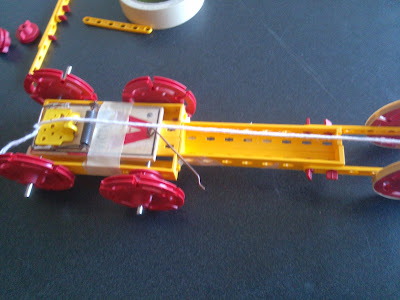The first part was challenge to complete was picking a good partner, and that was easy to do.
Quinn and I got the parts to build our car right away and started to brainstorm.
Criteria:
- Design, build and compete with a Mousetrap Racecar (at least 2 axles).
- Maintain a clean workspace
Constraints:
- One mousetrap
- No more than 12 inches of masking tape
- Fischertechnique robotics parts
- No more than 24 inches of string
- All materials must travel with your vehicle
- Work through the stages of the event
- Additional materials by Instructor approval
Achievement #1
"Brainiac"- brainstorm 10 ideas for your design
- Dune buggy style- long axles with wheels far away from the body
- Really fat tires
- Wheels wide set in the back and close in the front
- Wheels wide set in the front and close in the back
- Use string to secure the axles to the mousetrap
- Use tape to attach axle on bottom of the trap
- Use a third set of wheel to propel the car
- Use the plastic treads to keep the wheels straight
- Connect all of the axles together like the wheels of a train
- Set off the trap by pulling a piece of string
Achievement #2
"Visualize it!"- Create a sketch of design and label key parts
Achievement #3
"Build it!"- Build your design and document it with a photo
The evolution of our mousetrap racecar
Achievement #4
"The Price of Glory"- If each part you use costs $1, evaluate the total cost of your build
- 6 wheels: $6
- 8 yellow building pieces: $8
- 7 red attachment parts: $7
- 2 axles: $2
- 1 piece of string: $1
- 1 piece of tape: $1
- 1 mousetrap: $1
Total Cost: $26
Achievement #5
"Competitor"- compete in the 2nd Annual Mousetrap Racecar Challenge
Achievement #6
"Long Distance Winner!"- Travel the furthest in the distance race
Achievement #7
"Feedback"- Collect feedback
- + We won without adding extended length like
Achievement #8
"Re-work"- Change your build based on the experience with the race/feedback you collected. Document it
-Originally we had rubber bands on the 2 front wheels and the back 4 wheels
Race 1: (original build) We went 7 tiles and place 2nd to last
-We removed the rubber bands off the 2 outer rear wheels
Race 2: (Change 1) We only went 5 tiles
-We put the rubber bands back on the outer 2 rear wheels and removed the middle wheels and axle
Race 3: (Change 2) We went 10 tiles passing our furthest distance
-The string would unwind completely and then would rewind on the axle causing the car to go backwards. We extended the length of the string a few inches
Race 4: (Change 3) We went 20 tiles and moved into 1st place
-The extra length of the string helped a lot, so we decided to make it a little longer
Race 5: (Change 4) The extra string ended up just getting tangled around the axle and gave us a worse result
Achievement #9
Achievement #9
"Game Changer"- Develop a new rule or change to the game that you feel would make the event even better. Explain.
Creative Mode Challenge: Following the acceleration and distance events should be the creative mode challenge
- Each team during a set amount of time (10 minutes or so) can make a really creative change to their cars.
- With almost no limitations on what they want to add to it (no motors/battery powered additions)
- After the new addition have another distance race to see whose car can go the farthest
Achievement #10
"Name it"- Invent a name for an achievement that you think is better than one we currently have.
Change "Brainiac" to "Lightbulb Master": originating from Gru in Despicable Me whenever he comes up with a new idea
Achievement #11
"Leave it Cleaner Than You Found it!"- Did you leave your work space cleaner than you found it? Explain.
We left our work space cleaner than we found it by putting aside working on creating a blog post during class time to help sweep the floor and put away all the pieces of robotics kits covering the tables.
Achievement #12
"Design/Build"- What is a "Design/Build" process? How did your experience with this challenge relate to that? Why might you experience this in a career related to technical innovation?
The process is: define goals/needs of your build, brainstorm, prototype 1: labeled sketch/drawing, collaborate ideas for change, prototype 2: build the sketch, test it, feedback, change, and test again (keep changing and testing until satisfied). For this challenge we built our initial design and tried to just add things to that original idea, until the last minute when we couldn't get it to work. We decided to start from scratch and finally we got our car to move. During the races we changed our build a little bit each time until we were satisfied. When it comes to technical innovation, you won't know how to change things until you test them to see the flaws. You can't test them unless you design and build them, so if you want to be successful in the field than you will definitely run into some design/build processes.











.jpg)




